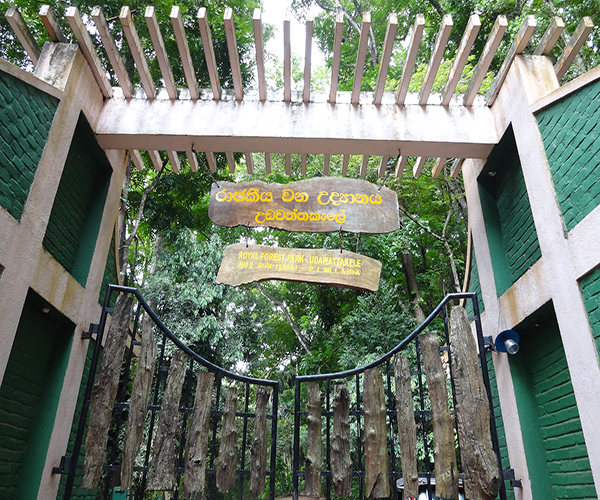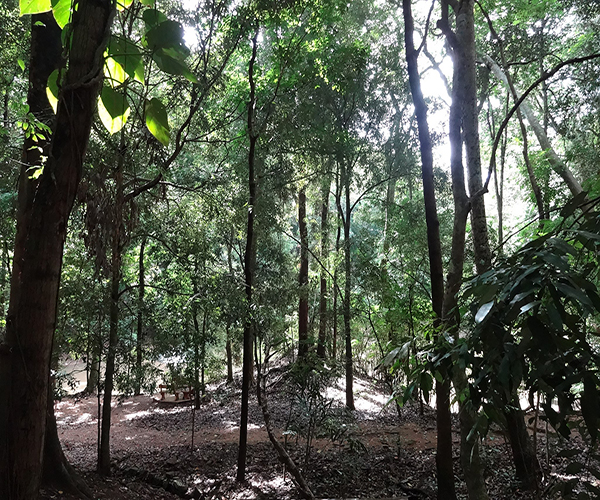Udawattakele Sanctuary – Royal Forest Park of Kandy City
By Arundathie Abeysinghe
 Udawattakele Sanctuary, popularly known as “Udawattakele” is a historic forest reserve situated on a hill-ridge behind Dalada Maligawa (Temple of the Sacred Tooth Relic) in Kandy City.
Udawattakele Sanctuary, popularly known as “Udawattakele” is a historic forest reserve situated on a hill-ridge behind Dalada Maligawa (Temple of the Sacred Tooth Relic) in Kandy City.
Udawattakele Sanctuary is also known as the Royal Forest Park. During the Kandyan Kingdom, Udawattakele Sanctuary was known as Uda Wasala Watta (Upper Palace Garden or the garden situated above the Royal Palace) as it was used by the royals, was a forbidden forest and out of bounds (Tahansikele) for ordinary people.
According to folklore, King Sena Sammata Wickramabahu (1473 – 1511), the first king of the Kandyan Kingdom, had his Royal Palace inside Udawattakele. The forest reserve had been a pleasure garden and a safe haven for the Royal family. During the Kandyan Kingdom, the Queens had used the pond in the Park for bathing and it was called the Royal Pond.
The Sanctuary is a vital biological reserve of Kandy City and the forest extent is about 257 acres. This is the only reserve bordered by a bustling city in Sri Lanka. The catchment areas of the forest reserve provide the majority of water resources to Kandy City.
Udawattakele is the first protected nature reserve in Sri Lanka. With the downfall of the Kandyan Kingdom in 1815, the pristine condition of the forest gradually deteriorated losing its antiquity due to illegal logging. Hence, in October 25, 1856, a gazette notification was issued to declare it as a nature reserve and since 1938 the forest has been declared a sanctuary.

According to legends, centuries ago, Kandy had been a Rain Forest and human settlements had taken place during King Parakramabahu’s era (1302-1326 AD). King Senasammata Wickramabahu (1469 – 1511) chose Kandy as his kingdom and had founded Kandy City.
According to folklore, in the past, there had been a tunnel underneath the Royal Palace that led to the ancient pond in the forest.
Udawattakele Sanctuary is of great religious importance as there are Buddhist meditation hermitages and three rock shelter dwellings for Buddhist hermit monks. The Sanctuary has three Buddhist Forest Monasteries; the Forest Hermitage, Senanayaka Aramaya and Tapovanaya as well as three ancient cave-dwellings which had been used by Buddhist hermit monks: Cittavisuddhi-lena, Maitiri-lena and Senkada-lena, (Senkanda Cave, a rock cave where *hermit Senkada had lived in a cave in the past). Hence, the forest has historical importance too.
The medieval rock dwellings of Buddhist monks and hermits are memoirs of yesteryear.
A water pond and the highest peak in the city known as Kodimale Peak are also situated in Udawattakele Sanctuary.
Udawattakele is rich in biodiversity, rare as well as endemic fauna and flora; over 400 species of plants, large number of mammals, about 70 species of birds and 32 diverse species of butterflies.
Many researchers have carried out research about fauna and flora in the Sanctuary.
The forest reserve has a canopy, sub canopy and an underground layer and its dense plant life restricts sunlight reaching the ground soil. The forest cover of the Sanctuary is rich with vegetation; canopy, sub-canopy and underground layer, dense forest, endemic species and an emergent layer. The Sanctuary also has a great variety of plant species, trees and shrubs including several lianas. The thick plant life obstructs sunlight from reaching the ground soil surface. The underground layer of the Sanctuary comprises of the canopy layer species as well as creepers which extends towards the top of the canopy layer trees, a breathtaking sight.
The forest cover towards north of Kandy Lake has many hardwood trees, lianas as well as giant bamboo trees. There is a giant ancient (about 200 – 300 year old) Pus wela (Entada pusaetha) in the Sanctuary. Among the other endemic trees in the Sanctuary are Ankenda (Acronychia pedunculata), Tel kekuna (Aleurites moluccana), Madatiya (Adenantheara pavonina) and Karawala Kebella (Antidesma bunius).
The Sanctuary is also famous for its extensive avifauna popular among foreign tourists, especially bird watchers. About 80 avifaunal species have been recorded in the Sanctuary. The forest reserve is home to 81species of birds including Ceylon white-headed babbler (Turdoides affinis taprobana), Gold-fronted leaf bird (Chloropsis aurifrons insularis), Ceylon brown-capped babbler (Pellorneum fusco capillum) and the Ceylon spotted ash-dove (Streptopelia chinensis ceylonensis). The endemic bird species at Udawattakele are Layard’s Parakeet (Psittacula calthropae), Three-toed Kingfisher (Ceyx erythacus), Yellow-fronted Barbet (Megalaima flavifrons) and Brown-capped Babbler (Pellorneum fuscocapillus). The two birds listed as threatened species, the Red-faced Malkoha (Phaenicophaeus pyrrhocephalus) and Kashmir Flycatcher (Ficedula subrubra) can also be found in the forest reserve.
Tall canopies of Udawattakele Sanctuary provide fresh water to Kandy Lake and Kandy City gets its purified air supplies from this forest reserve.
The Sanctuary is home to endemic fauna ranging from the fishing cat (Prionailurus viverrinus), palm squirrel (Funambulus palmarum), hare (Lepus) and deer (Axis axis ceylonensis). There are also many endemic mammals in the Sanctuary such as the Pale-fronted Toque Macaque (Macaca sinica aurifrons), Mouse deer (Moschiola meminna), Porcupine (Hysterix indica), Golden Palm Civet (Paradoxurus zeylonensis), Small Indian Civet (Viverricula indica), Ruddy Mongoose (Herpestes smithii), Indian Giant Flying Squirrel (Petaurista philippensis), Asian Palm Civet (Paradoxurus hermaphroditus) and Indian Flying Fox (Pteropus giganteus) also known as great Indian fruit bat.
In 1834, Sir William Horton, Governor of Ceylon (1831 – 1837) built the first road through the Sanctuary and named it as Lady Horton’s Drive (named after his wife). According to Henry W. Cave, the trail had been about five kilometers (three miles) long. There are also many other roads in the Sanctuary such as Lady McCarthy’s Drive, Lady Torrington’s Road, Lady Anderson’s Road, Lady Gordon’s Drive, Gregory Path, Russell Path and Byrde Lane.
The short walks in the Sanctuary including Lady McCarthy’s Drive, Lady Torrington’s Road and Lady Gordon’s Road are visual delights.

The British Garrison Cemetery is also in the lower section of the forest reserve. Sri Lanka Forest Department has two offices in the forest reserve and a nature education center with pictures and posters. The forest reserve is visited by naturalists as well as undergraduates and school children.
Udawattakele is a popular destination of nature lovers and bird watchers.
Location: Behind Temple of the Sacred Tooth Relic
Directions: Visitor’s entrance to the Sanctuary is located on the western side about 15 – 20 minutes from the Temple of the Sacred Tooth Relic. From the Temple of the Sacred Tooth Relic travel north along D.S. Senanayaka Veediya and after about half a kilometer turn right at the Post Office situated near Kandy Municipal Council. Travel along the road situated along the hill. The entrance to the Sanctuary is situated on the right side of the Tapovanaya Monastery.
Tourists can purchase a map of Udawattakele Sanctuary from the ticket office. Last tickets to enter the Sanctuary are issued at 4.30 p.m.
- Senkada – Kandy was known as Senkadagala or Senkadagalapura during the Kandyan Kingdom. According to folklore, during King Wickramabahu’s era, Kandy was known as Senkadagala as the hermit Senkada had lived in a cave in Udawattakele Sanctuary.







